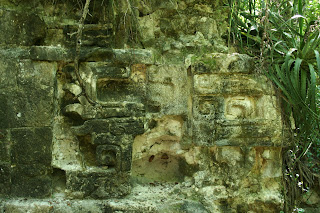 The best remaining mask, one of a stack of masks very much like ones seen far to the north at the Chenes site Xichmook.
The best remaining mask, one of a stack of masks very much like ones seen far to the north at the Chenes site Xichmook.
The next stop was the ruins of Balamku. Balamku is a Peten style site with Rio Bec style appearing only at the very end. It seemed to me there was much Rio Bec influence in the early buildings, but rescent work has classified this as a Peten site because the ceramic material is consistent with Peten style sites, not with Rio Bec sites. Balamku is a moderate sized site, with three groups of monumental structures, two which are open to the public.



 The Rio Bec wing of the palace with a the remains of a 'twin tower' style temple.
The Rio Bec wing of the palace with a the remains of a 'twin tower' style temple.
The famous frieze uncovered by looters and was found before it was removed. It is hard to believe, but a freize like this turned up in New York City on the black market. It originated from a ruin about 50km south of Xuphil. Looters were able to remove it, pack it and get it all the way to New York. A researcher was approach in an atempt to find a buy and an he turned them in. The freeze is now in the Mexico City museum. This is the upper part of the building, and a door can be seen below.
The masks uncovered at Ek Balam look very much like this, and is probably a good representation of Rio Bec style masks, however this example is probably from the late Early Classic, before the Rio Bec style was formalized. While the masks look mostly red, there is much fine details of paint still visable.
This type of imagry appeared on ceramics around 550AD.
The campsite, I rented the tent.
Distance rode: 73km
Total: 1544km










 The same snake after a few wacks with a stick.
The same snake after a few wacks with a stick. Our guide in a tree. Had to see him and he is only about half way up. I have never seen anyone climb a tree so well, and an adult at that!
Our guide in a tree. Had to see him and he is only about half way up. I have never seen anyone climb a tree so well, and an adult at that!
 Looking out from the massive trench/tunnel under the buliding with the true arch.
Looking out from the massive trench/tunnel under the buliding with the true arch. The view from the second tallest temple at the site. This temple is very tall, but the whole site is built on a very tall hill surounded by flat plains. When cleared of forest, these ruins will be very impressive.
The view from the second tallest temple at the site. This temple is very tall, but the whole site is built on a very tall hill surounded by flat plains. When cleared of forest, these ruins will be very impressive.


 A large middle classic Rio Bec building. The pyrimid base has a network of halls and rooms with ceilings some 25ft tall. There is a small enterance in the rear, but it had been blocked off with stones so people like me will not go in.
A large middle classic Rio Bec building. The pyrimid base has a network of halls and rooms with ceilings some 25ft tall. There is a small enterance in the rear, but it had been blocked off with stones so people like me will not go in. Proabably the earliest uncovered monstermouth door at Becan. While most have carved stone covered with stucco for fine detail, this one was done entirly with stucco, only stone pegs remain on the wall to hold the stucco in place.
Proabably the earliest uncovered monstermouth door at Becan. While most have carved stone covered with stucco for fine detail, this one was done entirly with stucco, only stone pegs remain on the wall to hold the stucco in place. 
 The road north of Xuphil
The road north of Xuphil An unusual stella, plain but with a boarder like one seen in doorways of southern Puuc ruins.
An unusual stella, plain but with a boarder like one seen in doorways of southern Puuc ruins.



























